Ibike Korea People-to-People Program
 Photo essay: Ulchin to
Ganggu
Photo essay: Ulchin to
Ganggu
Points of Interest: Squid fishing villages, Wosang Pavillion, sandy beaches, rocky coast, coastal defenses
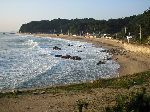
 The beach at sunrise
(left). Even
without the quid the views are grand, dramatic, thought provoking, and
philosophical. This is a ride as much about what you see and how it makes you
think, as about the physical pleasure of the ride. Mile after mile the surf rolled in (right)
The beach at sunrise
(left). Even
without the quid the views are grand, dramatic, thought provoking, and
philosophical. This is a ride as much about what you see and how it makes you
think, as about the physical pleasure of the ride. Mile after mile the surf rolled in (right)
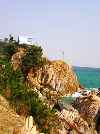 The other view on the
coast is preparation against possible North Korean infiltration. It is not
an imaginary threat because over the decades there have been attempts using
fishing boats, rafts and small submarines (and tunnels) to get personnel into
South Korea. Upland in the area there are periodic military bases, and
scattered along the coast there is a series of observations posts (right). Some
are more camouflaged than others and from casually passing by, it is not clear
if or when they are manned. Isolated
parts of the coast road are lined with chain link fence, topped with razor wire (left)
-- and who knows what defensive preparations we can't see. Amidst this, day-to-day life seems to go on unconcerned and unperturbed by any threat.
The other view on the
coast is preparation against possible North Korean infiltration. It is not
an imaginary threat because over the decades there have been attempts using
fishing boats, rafts and small submarines (and tunnels) to get personnel into
South Korea. Upland in the area there are periodic military bases, and
scattered along the coast there is a series of observations posts (right). Some
are more camouflaged than others and from casually passing by, it is not clear
if or when they are manned. Isolated
parts of the coast road are lined with chain link fence, topped with razor wire (left)
-- and who knows what defensive preparations we can't see. Amidst this, day-to-day life seems to go on unconcerned and unperturbed by any threat.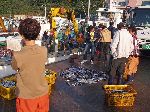
 Not
all the fishing is for squid. It is fascinating to watching the
fishing boat arrive at the wharf in the morning. They are met by a throng
of buyers equipped with note pads and cell phones.
Not
all the fishing is for squid. It is fascinating to watching the
fishing boat arrive at the wharf in the morning. They are met by a throng
of buyers equipped with note pads and cell phones.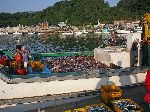
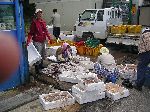
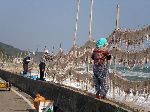

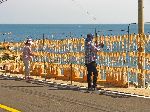 Once
cleaned they need to be hang, flip and dress the squid.
Once
cleaned they need to be hang, flip and dress the squid.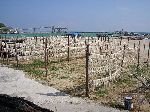
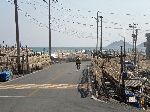
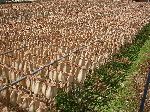
 Granted
it was very much the exception, not the rule: More than once I saw squids
hung on the same line as the regular laundry -- it was hard to resist the
impulse to take a photo (right). This is squid country.
Granted
it was very much the exception, not the rule: More than once I saw squids
hung on the same line as the regular laundry -- it was hard to resist the
impulse to take a photo (right). This is squid country.Are there any left in the ocean? And, who is eating all of this dried squid?
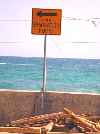
 From
the surrealistic world of dried squid one is brought back to reality by the
tsunami warning signs. But these might be as reality based as they seem. These
were new along the coast,
between 2004 and 2006, and show evacuation routes. They are probably a response to the
Indian Ocean
tsunami of December 2004. It is interesting that the "Evacuation Route"
signs (left) are primarily English (for the itinerate visitor) and the detailed
evacuation procedure signs (right) are entirely Hangul (for the permanent
resident).
From
the surrealistic world of dried squid one is brought back to reality by the
tsunami warning signs. But these might be as reality based as they seem. These
were new along the coast,
between 2004 and 2006, and show evacuation routes. They are probably a response to the
Indian Ocean
tsunami of December 2004. It is interesting that the "Evacuation Route"
signs (left) are primarily English (for the itinerate visitor) and the detailed
evacuation procedure signs (right) are entirely Hangul (for the permanent
resident).
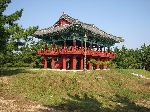

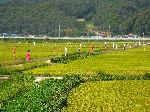 Here we take a shortcut
through the rice fields. The farm roads, which are smooth concrete, become
our private bike trails. I sure beats the highway. We have no
complaints because we have avoided heavy traffic 90% of the time or more.
Here we take a shortcut
through the rice fields. The farm roads, which are smooth concrete, become
our private bike trails. I sure beats the highway. We have no
complaints because we have avoided heavy traffic 90% of the time or more.One farm dressed dozens of "scare crows" in traditional hanbok (formal Korean dress).
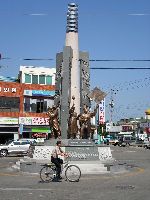
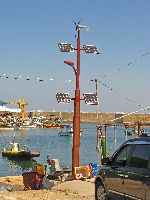 Monument commemorating
the struggle and liberation from the
Japanese (left).
Monument commemorating
the struggle and liberation from the
Japanese (left).A sustainable power pole (right) with a wind power generator and several solar photo voltaic panels.
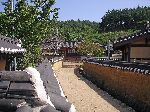
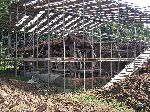
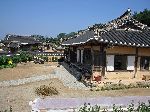
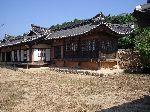
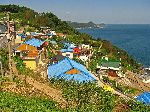
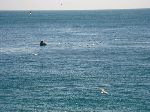 Interspersed
with the other attractions is a rugged coastline (think beautiful). Inspiring
panoramas kept coming hour after hour all day long. Between the hanging squid,
fishing villages, crashing surf and coastal cliffs, this must be one the most
scenic rides in Korea. Houses
perched on the hills above the ocean would have "million dollar views" if in
North America (left).
Interspersed
with the other attractions is a rugged coastline (think beautiful). Inspiring
panoramas kept coming hour after hour all day long. Between the hanging squid,
fishing villages, crashing surf and coastal cliffs, this must be one the most
scenic rides in Korea. Houses
perched on the hills above the ocean would have "million dollar views" if in
North America (left).A man is fishing close to shore (right).

 When you only visit
someplace once you only get a snapshot of life. It is hard to get a feel
of where it has come from and where it is going. Visiting more than once you get
slightly more understanding of the dynamism of the society. That is
reflected in this wind farm which was rugged hill tops before and then appeared
in 2006. Bearing in mind that wind farms are located in windy places,
it is an provocative questions, "how do they make repairs to the blades?"
Answer: They send a man up on a long boom (right). The five foot high man
is probably at least 150 feet above the ground. The other turbines were spinning
when the picture was taken -- the wind was blowing!
When you only visit
someplace once you only get a snapshot of life. It is hard to get a feel
of where it has come from and where it is going. Visiting more than once you get
slightly more understanding of the dynamism of the society. That is
reflected in this wind farm which was rugged hill tops before and then appeared
in 2006. Bearing in mind that wind farms are located in windy places,
it is an provocative questions, "how do they make repairs to the blades?"
Answer: They send a man up on a long boom (right). The five foot high man
is probably at least 150 feet above the ground. The other turbines were spinning
when the picture was taken -- the wind was blowing!Let this be a not so subtle reminder that the coast can be windy. Riding the coast is a totally different ride if you do it going with the wind, as opposed to into the wind. As much as I like some exercise, I have a strong preference for ride with the wind.
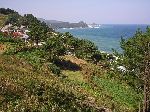
 Rugged coastline (think beautiful) along the East
Sea, north of Ganggu. Inspiring panoramas kept coming hour after hour all
day long. Between the hanging squid, fishing villages, crashing surf and coastal cliffs,
this is perhaps the most scenic day of the trip.
Rugged coastline (think beautiful) along the East
Sea, north of Ganggu. Inspiring panoramas kept coming hour after hour all
day long. Between the hanging squid, fishing villages, crashing surf and coastal cliffs,
this is perhaps the most scenic day of the trip. 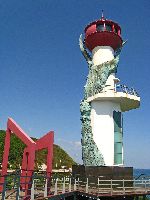
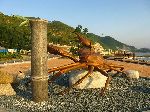
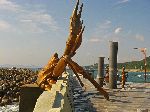 For
lack of a better moniker the coast around Ganggu can be called the "Crab Coast".
Crabbing seems to be a main industry and even small fishing villages have large
crab sculptures in them.
For
lack of a better moniker the coast around Ganggu can be called the "Crab Coast".
Crabbing seems to be a main industry and even small fishing villages have large
crab sculptures in them.



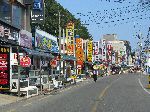
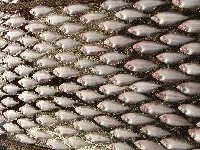
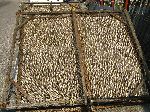 Almost
every storefront in the photo on the left, along the waterfront, is a
restaurant. Crab restaurants out-numbered live fish restaurants about
ten-to-one.
Almost
every storefront in the photo on the left, along the waterfront, is a
restaurant. Crab restaurants out-numbered live fish restaurants about
ten-to-one.Not everything in Ganggu is crab. There was fish drying in racks along the side of the road, fish markets, a jetty to walk out, the harbor to enjoy, colonies of birds, and a somewhat normal commercial district. Away from the water front there are also chicken and meat restaurants.
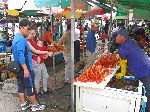
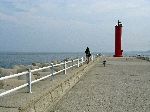
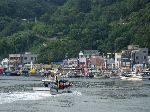
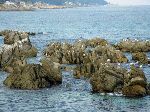
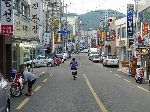
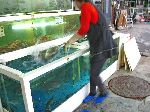
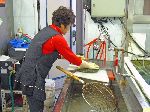
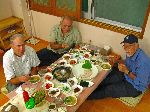 For
dinner you can select a live fish or crab
from the case (depending upon the restaurant and your taste). It is prepared on the spot. And then it becomes
part of a large meal.
For
dinner you can select a live fish or crab
from the case (depending upon the restaurant and your taste). It is prepared on the spot. And then it becomes
part of a large meal.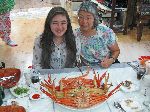
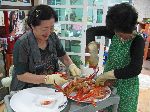 Of
course crab is the specialty, but it is no bargain and it is not fast food.
The whole process of a crab dinner involves several courses takes well over an
hour.
Of
course crab is the specialty, but it is no bargain and it is not fast food.
The whole process of a crab dinner involves several courses takes well over an
hour.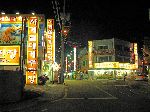
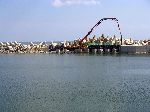 Ganggu
at night (left), and
Ganggu
at night (left), and building a breakwater around "the harbor" (right), which eventually will cease to be a harbor as they fill it in as a "land reclamation" project..
 Please
contact us if you would like to be added to
Ibike's mailing list or have questions, comments, corrections or criticism. (Also, please let us know how you learned about us and
found this site.) Privacy policy.
Please
contact us if you would like to be added to
Ibike's mailing list or have questions, comments, corrections or criticism. (Also, please let us know how you learned about us and
found this site.) Privacy policy.
![]() IBF Homepage
IBF Homepage ![]() Ibike Programs
Ibike Programs
![]() Ibike Schedule
Ibike Schedule
![]() Search
Search



